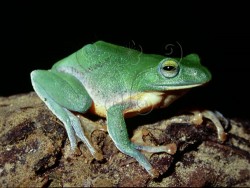|

|

|
Introduction
The Taipei tree frog is an endemic species of Taiwan. They are mostly found in mid-low elevation mountainous regions north of Nantou county, mainly in Taipei, Miaoli, and Yi-Lan counties respectively. They are one of the few species of frogs that reproduce during winter, with breeding seasons lasting from October until April of the following year.
Comparisons with related species: The Moltrechtis green tree frog has orange irises, black spots on the sides of the body, and orange coloring on the inner thighs.
Morphology
Adult characteristics: This species is medium- to small-sized, with body lengths ranging from 3 to 4 centimeters. The snout tip is obtuse and the edge is not visible. They have horizontal pupils; the irises are colored in yellowish green or silver-grayish green; the tympanum is not visible. The dorsal surface is smooth and colored in bright green or dark green, sometimes yellowish-green or brownish-yellow, which alternates depending on changes in environments or reproductive states. Some individuals have white, yellow or blue spots, and there are no mid-dorsal stripes or dorsolateral folds. The ventral surface is light yellow, and the sides are yellow and adorned with minute brown spots.
The edges of the limbs have visible skin flaps, flat digits, webbed toes, sucker pads and yellowish web membranes. The males have outer vocal sacs.
Tadpole characteristics: The body lengths range from 8.2 to 14.3 millimeters (stage 34-38) and are oval-shaped. The snout is circular and the mouth is located at the snout end. The eyes are located on the dorsal side, with a blow hole on the lower lateral side of the body. The dorsum is light brown with grayish-green accents and adorned with dark brown spots. The fin and tail muscles are mottled on both sides, the tail is lanceolate-shaped, with a sharply tipped end.
Egg characteristics: The eggs are a creamy white color and are laid into white foam masses.
Habits and habitats
This species is found mostly in wet cultivated patches, river sides, ponds and mud bushes around swamps. During rainy winter nights, they emit a low, monotonous “ger”sound; when in large numbers, their calls turn into rhythmic “ger-ger-ger” sounds with 3-4 syllables, sometimes ending with “lo-lo-lo” to increase variety and attraction.
The males of this species exhibit nesting and mating call behavior; when females approach, males emit mating calls that contain dozens of syllables; when two males meet, they emit a coarse “gah” contact call, and fight with their front limbs. The females lay eggs in trees, and cover them in foamy substances. Their diets include ground insects and arthropods.
National Museum of Natural Science
|